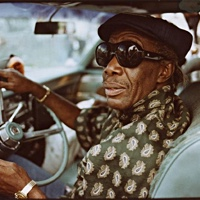Home » Jazz Musicians » Professor Longhair
Professor Longhair
"Fess"
One of the principal pioneers of New Orleans rhythm & blues, his influence can be heard in Fats Domino, Allen Toussaint, James Booker and Dr. John, among many others. Known for his unique mix of blues, jazz, calypso, ragtime, and zydeco, "Fess" (as he was known) defined and captured the essence of New Orleans in his music.
Born Henry Roeland Byrd in Bogalusa, Louisiana 1918, and raised in New Orleans, Fess started performing at an early age, often dancing down Bourbon Street for tips. In addition to piano, he learned to play guitar and drums in the early 1930s and was in and out of numerous bands. He soon found there were better ways to make money than music. He worked as a cook, then as a boxer, and eventually became a professional card player. It wasn't until the late 1940s that he returned to music.
He went into the army during World War II, and was discharged in 1943. At that point he led a variety of groups, including the Mid Drifs, Professor Longhair and the Four Hairs, and Professor Longhair and His Shuffling Hungarians. Debuting on Star Talent records in 1949, Fess laid down the first version of his signature "Mardi Gras in New Orleans," featuring the unmistakable whistled intro and backing band the Shuffling Hungarians. Longhair's next date was for Mercury producing his first and only national R&B hit in 1950, "Bald Head," under the name Roy Byrd & His Blues Jumpers. Longhair made other great recordings for various labels early in his career most notably for Atlantic Records in 1953 producing the immortal "Tipitina," a romping "In the Night," and the boogie "Ball the Wall". Longhair came back on Ebb records in 1957 with the wailing "No Buts - No Maybes." He re-recorded the seminal local anthem "Go to the Mardi Gras" for Ron records in 1959. This is the version played every year during Carnival in New Orleans, and is still one of the most beloved songs in the New Orleans music songbook.
Despite recording such classics as “Tipitina,” “Big Chief,” and “Going to the Mardi Gras,” he never received much exposure outside of Louisiana, although his reputation in New Orleans was substantial. Even though a local legend, Fess was forced to support himself by returning to cards and working as a janitor in the mid- 1960s.
Fess' career was resurrected in the early 70s with the help of his then manager Allison Miner and New Orleans Jazz & Heritage Festival founder, Quint Davis. His performance at the 1971 Jazz Festival put him on the comeback trail. Atlantic recorded him in 1971-72 in what would be known as “House Party New Orleans Style: The Lost Sessions.” There was also some other dates for Rhino released as “Mardi Gras in Baton Rouge,” these were also done in 1971-72. He toured Europe, headlining the 1973 Montreux Jazz Festival. He made a few albums in the last decade of his life, including “Rock 'n Roll Gumbo,"(1977) and “Live on the Queen Mary.”(1978)
Read moreTags
Nostalgic for New Orleans: Brass Bands, Classic R&B, Trad and New Jazz

by David Brown
I'm nostalgic for New Orleans. Once my home, I just visited after 19 years. This week, R&B with Irma Thomas, Allen Toussaint, Lee Dorsey, Ernie K-Doe & Professor Longhair. Then trad jazz with Panorama Jazz Band, Sidney Bechet and Louis Armstrong. We'll second line with the Panorama, Treme, Dirty Dozen and Rebirth Brass Bands, and much more from the city that care forgot. We'll then go down river and into the gulf for some new and classic Cuban sounds.
Continue ReadingVarious artists: Alligator Records: 50 Years of Genuine Houserockin’ Music

by Jim Trageser
Maybe this half-century commemoration of the Chicago-based, blues-focused label should have been titled, “The Last of the Independents." Almost alone of the mid-major labels that formerly thrived in the 1980s and '90s by specializing in non-mainstream styles of music, Alligator has managed to navigate stunning changes in the music business--from the vinyl of LPs and 45s to cassettes and CDs, and then, most recently, the virtual collapse of the retail record business and wholesale pivot to online digital ...
Continue ReadingProfessor Longhair: The Bach of Rock

by Scott Gudell
Some people swear Professor Longhair (1918--1980) was at the very first New Orleans Mardi Gras back in 1699. However, the truth is that he probably started boppin' and hoppin' at the annual celebration a few years after World War I. He kept going until he passed in 1980 and he experienced over a half century of catching beads, chasing rolling doubloons and franticly waving the gold, green and purple. Oh, the eerie torchlight parades, opulent floats and boisterous parties he ...
Continue ReadingSat Eye Candy: Professor Longhair

Source:
JamBase
HAPPY FREAKIN' BIRTHDAY, FESS !!!
As a college student eking out a living at long defunct Cymbaline Records in Santa Cruz, one of our regulars was New Age music superstar George Winston. His albums December and Winter Into Spring were the definition of textural piano bliss, and every jerk water in a cardigan came in with their little yap dog to buy copies in the late 1980s. Given the character of his music one might assume the dude was majorly ...
read more






































